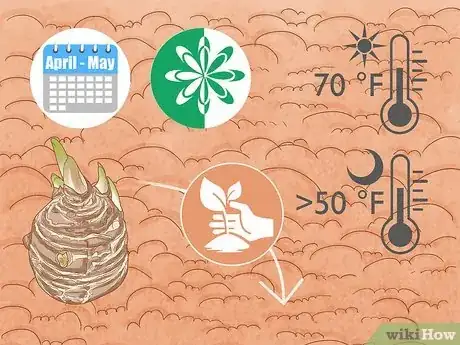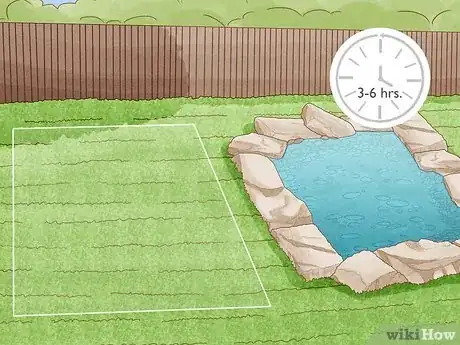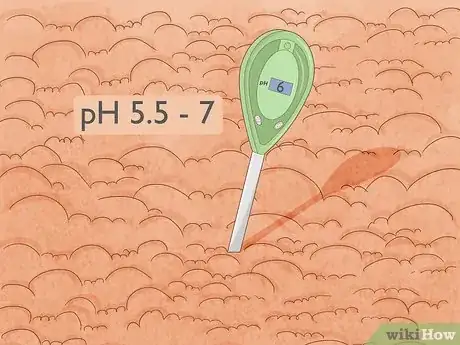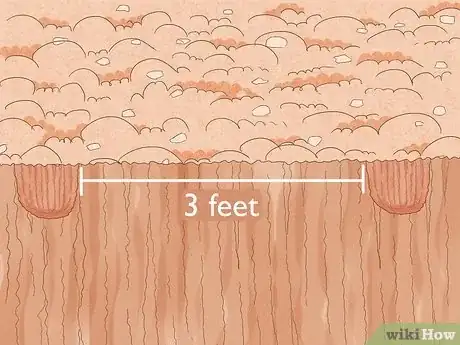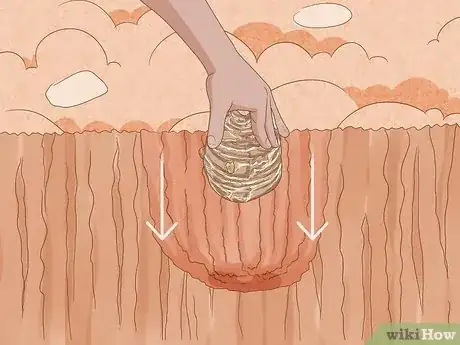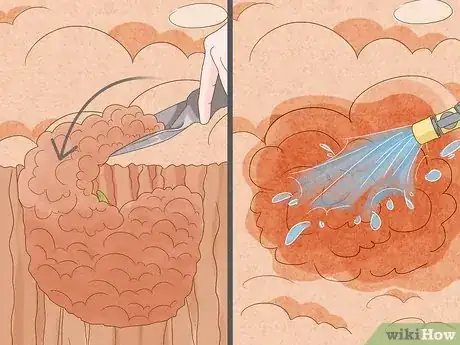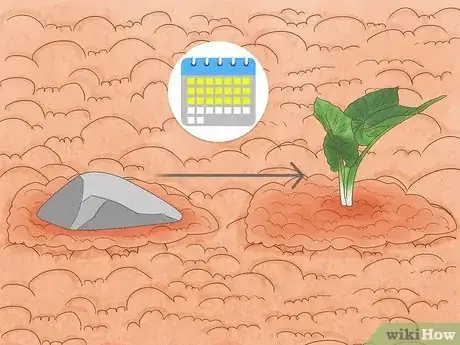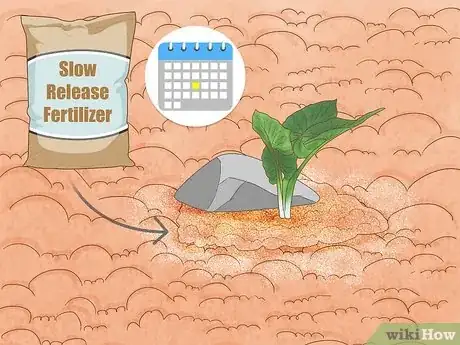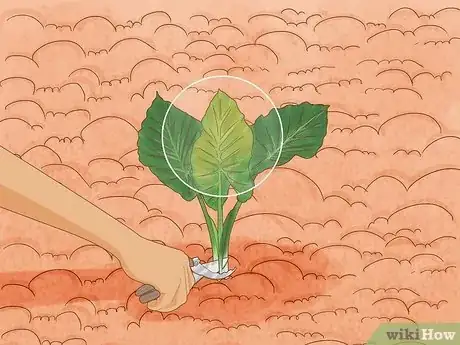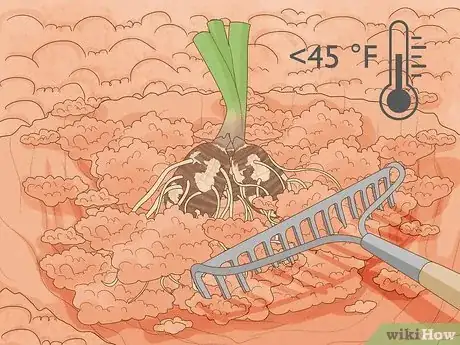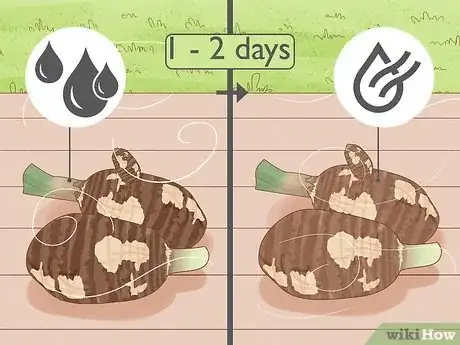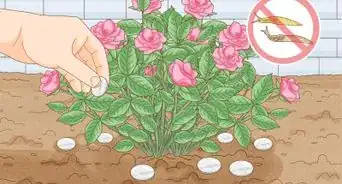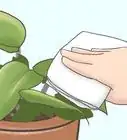This article was co-authored by Lauren Kurtz. Lauren Kurtz is a Naturalist and Horticultural Specialist. Lauren has worked for Aurora, Colorado managing the Water-Wise Garden at Aurora Municipal Center for the Water Conservation Department. She earned a BA in Environmental and Sustainability Studies from Western Michigan University in 2014.
wikiHow marks an article as reader-approved once it receives enough positive feedback. This article has 30 testimonials from our readers, earning it our reader-approved status.
This article has been viewed 1,438,358 times.
The Elephant Ear (Colocasia) is a tropical plant that grows up to 9 feet (2.7 m) tall and sprouts large, arrow-shaped leaves that resemble the ears on an elephant. To grow these stunning plants, plant the bulbs in the early spring with the right soil conditions. Care for them properly with frequent watering and fertilizing to watch them flourish. When it gets cold outside, dig up the bulbs to store them and plant them again next spring. If you live in USDA hardiness zone 8 or above, you can leave your elephant ears in the ground to regrow the next spring.
Steps
Planting Your Elephant Ear
-
1Plant in the spring when nighttime temperatures are above 50 °F (10 °C). Wait until there’s no chance of frost occurring overnight so the plant won’t get damaged. This is often in April or May.[1]
- The ideal daytime temperature will be around 70 °F (21 °C).
Tip: If you want to speed up the process, plant your bulbs in a pot inside a few weeks before early spring. Then, when it’s warm enough, transfer them to your garden.
-
2Pick an area that receives indirect sunlight. Too much sun can burn the leaves of your plant. You’ll want to place your plant somewhere that has partial shade and will keep the soil moist for the plant. Typically, that means 3 to 6 hours of sun exposure per day.[2]
- If a plant isn’t getting enough sun, you’ll notice the leaves turning yellow.
- The sunnier the spot, the more you'll have to water the plant to prevent the soil from drying out.
Advertisement -
3Find a spot that is very moist with good drainage. Elephant ears are used to tropical climates with high humidity. Plant them in soil that retains a lot of moisture like by a pond or swampy area. Drainage is equally important so that the plant’s roots don’t rot.[3]
- Recreate tropical conditions in your garden by keeping the soil moist and not letting it dry out.
- Using a raised bed or installing a drainage system in your garden can help avoid overwatering.
- Test the drainage by digging a hole about 1 foot (0.30 m) deep and filling it with water. If it takes longer than 4 hours to empty, you have poor drainage.
- Don't oversaturate your soil when you water your elephant ears.
-
4Test for rich soil that has a pH level between 5.5 and 7. A pH of 7 is considered neutral. Elephant ear plants prefer organic soil that’s slightly more acidic. Use a home pH kit to test your soil and determine if it’s the right level for your plants.[4]
- To lower a soil’s pH, add some sulphur, gypsum, or organic compost.
- To increase a soil’s pH, sprinkle a little garden lime or limestone into the soil.
-
5Place the holes for your bulbs at least 3 feet (0.91 m) apart. Adult elephant ears not only boast large leaves, they can also spread very quickly via runners. Leave enough space when you’re planting to allow the plants to grow freely.
- Choose a clumping variety of elephant ears if you don’t want them to spread.[5]
- If you don't plant them far enough apart, the elephant ears will steal sunlight and water from each other. A larger plant will cover a smaller one, for example, so the leaves of the smaller plant can't get enough light.
Prevent Elephant Ears from Taking Over Your Garden
Pick the Colocasia variety. This plant often produces a clump of plants in a smaller space rather than running rampant.
Dig a 6 in (15 cm) border around the bulbs. Contain the runners by creating a deep edge between the elephant ears and other plants ins your garden.
Divide the elephant ears when they outgrow the plot. Dig up and replant some of your elephant ear plants to spread them out. This will help avoid overcrowding.
Move your plants to containers. If all else fails but you still love the look of elephant ears, transfer them to pots. Sit them outside or bring them indoors.
-
6Dig a hole so the bulb sits 1 to 2 inches (2.5 to 5.1 cm) below the soil. Elephant ears grow best when they’re planted close to the surface. A general rule of thumb is that the hole should be 2 to 4 times larger than the bulb. Use a spade or garden shovel to dig up the soil.[6]
- The bulbs will push upwards as they grow so it's important to leave enough space that they won't break through the soil.
- Larger bulbs will need slightly deeper holes.
-
7Set the bulb in the hole with the flat end facing down. It's hard to figure out which end of an elephant ear bulb is which since there are no defined points. The top of the bulb is the end with concentric circles around it. That part should be facing up. Press it firmly into the soil.[7]
- The bottom may also have some root hairs leftover from the previous season.
- If you can’t tell which end is the bottom, lay the bulb on its side in the hole. The roots will be able to grow down and the greens will grow up naturally.
-
8Cover the bulb completely with soil and water it thoroughly. There should be about 1 to 2 inches (2.5 to 5.1 cm) of soil over top the bulb. Press the soil down firmly with the palm of your hand, making sure no sections of the bulb are exposed. Water the area so that the soil around the bulb is saturated.[8]
- Elephant ears require a lot of water, especially when they’re first planted.
-
9Mark the spot where the bulb is planted. It will take a few weeks for the plant to emerge from the soil. Use a stake, stone, or other marker so you don't forget where you planted the elephant ear. Make sure you place your marker next to the bulb, not directly over top of it.
- This helps if you’re planting other plants, flowers, or bushes in your garden so you know where everything is growing and don’t accidentally overcrowd them.
Caring for the Plant
-
1Wait 1 to 3 weeks before expecting your first sprout. The amount of time it takes for the first shoots to poke through the soil depends on the air and ground temperature. Cooler temperatures may slow the plant’s growth.[9]
- If there's still no sprout after 3 weeks, carefully dig up the bulb to inspect it for rot. Cut off any bad spots, then plant it again.
-
2Water the plant in the morning at the roots to keep the soil moist. Since elephant ears are tropical plants, they require a lot of moisture. Water the plant as close to the soil as possible underneath the foliage so you avoid getting the leaves wet. It’s best if the plant is dry at night to prevent diseases.[10]
- Never let the plant dry out between watering. This stresses the plant.
- Drooping leaves signal that the plant needs more water.
-
3Fertilize your plant once a month with a slow-release fertilizer. Elephant Ear plants are heavy feeders and flourish in fertile soil. A slow-release fertilizer keeps your plants fed by gradually releasing nutrients in the soil to promote steady, consistent growth. It also requires less maintenance on your part.[11]
- Look for a fertilizer that’s high in nitrogen. Nitrogen helps the plant produce chlorophyll, which gives the leaves that gorgeous green color.
- Mix compost matter or manure into the soil for extra nutrients.
-
4Trim away faded or browning leaves as needed. This will encourage new leaves to grow and keep your garden looking lively. Use garden shears to remove the bad leaves as close to the bulb as possible without cutting the bulb.
- Wear gloves when you’re trimming the leaves if you have sensitive skin. Their are certain compounds in the leaves that can irritate your hands.
- A lot of brown or yellow leaves are a sign the plant is either not getting the right amount of sunlight or isn't getting enough water.
Harvesting and Storing the Plant in the Winter
-
1Cut the leaves to 1⁄2 in (1.3 cm) when it stops producing new leaves. Slower leaf production is a sign it’s almost time to store your plant for the winter. In preparation, trim down the leaves to just above the bulb.[12]
- Yellow leaves are another sign the plant is going dormant.
- You can discard the leaves or keep them to wrap the bulbs in for storage.
- Be careful not to cut into or damage the bulb itself.
- The best time to cut the leaves is early to mid fall.
-
2Dig up the plant when the temperature drops below 45 °F (7 °C). The plant will start having difficulties and likely go dormant when the temperature is below 45 °F (7 °C) for more than a few days or when the first frost hits. Use a garden shovel to carefully dig up the plant.[13]
- If you live in a tropical, warm climate, you may not need to dig up your plant. Treat it like any other perennial and bury it under a layer of mulch at least 3 inches (7.6 cm) deep.
-
3Let the bulbs dry completely for 1 to 2 days. Drying out the bulbs minimizes the potential for mold and bacteria to develop. Set the bulbs in a dry, room temperature spot, either inside or outside. Wait until they’re totally dry to the touch.[14]
- Keep them out of reach of children or pets. If there are any remnants of leaves on the bulbs, they’re poisonous.
-
4Place the bulbs in a paper bag with holes for ventilation. Never use an airtight container as this traps in moisture and can cause the bulb to rot. A slotted paper bag allows any excess dampness to evaporate.[15]
- Wrap the bulbs in leaves from the plant, sphagnum peat moss, or garden vermiculite to protect them further.
- If you don't have a paper bag, a mesh bag will work.
-
5Store the bulbs in a cool, dry place between 45 and 55 °F (7 and 13 °C). During the winter months, keep the bag with the bulbs somewhere with low humidity to prevent the bulbs from molding. An unheated basement or garage are both good options.[16]
- Check the bulbs every so often. If you notice that one is rotting, throw it away so it doesn’t spread to the others.
Expert Q&A
Did you know you can get premium answers for this article?
Unlock premium answers by supporting wikiHow
-
QuestionCan I plant them in direct sun?
 Lauren KurtzLauren Kurtz is a Naturalist and Horticultural Specialist. Lauren has worked for Aurora, Colorado managing the Water-Wise Garden at Aurora Municipal Center for the Water Conservation Department. She earned a BA in Environmental and Sustainability Studies from Western Michigan University in 2014.
Lauren KurtzLauren Kurtz is a Naturalist and Horticultural Specialist. Lauren has worked for Aurora, Colorado managing the Water-Wise Garden at Aurora Municipal Center for the Water Conservation Department. She earned a BA in Environmental and Sustainability Studies from Western Michigan University in 2014.
Professional Gardener
-
QuestionDo I have to dig them up every winter, or can I leave the tuber in the ground?
 Lauren KurtzLauren Kurtz is a Naturalist and Horticultural Specialist. Lauren has worked for Aurora, Colorado managing the Water-Wise Garden at Aurora Municipal Center for the Water Conservation Department. She earned a BA in Environmental and Sustainability Studies from Western Michigan University in 2014.
Lauren KurtzLauren Kurtz is a Naturalist and Horticultural Specialist. Lauren has worked for Aurora, Colorado managing the Water-Wise Garden at Aurora Municipal Center for the Water Conservation Department. She earned a BA in Environmental and Sustainability Studies from Western Michigan University in 2014.
Professional Gardener
-
QuestionDo elephant ear bulbs multiply?
 wikiHow Staff EditorThis answer was written by one of our trained team of researchers who validated it for accuracy and comprehensiveness.
wikiHow Staff EditorThis answer was written by one of our trained team of researchers who validated it for accuracy and comprehensiveness.
Staff Answer wikiHow Staff EditorStaff Answer
wikiHow Staff EditorStaff Answer
Warnings
- The leaves contain oxalic acid which is toxic when eaten raw. Keep children and animals away from the plants. If poisoning occurs, go to the hospital immediately.⧼thumbs_response⧽
- Wear gloves when planting or handling your plant if you have sensitive skin.⧼thumbs_response⧽
References
- ↑ https://www.gardeningchannel.com/when-to-plant-elephant-ear-bulbs/
- ↑ https://www.gardendesign.com/plants/elephant-ear.html
- ↑ https://www.gardendesign.com/plants/elephant-ear.html
- ↑ https://www.gardeningchannel.com/when-to-plant-elephant-ear-bulbs/
- ↑ https://www.gardendesign.com/plants/elephant-ear.html
- ↑ https://www.epicgardening.com/elephant-ear-plant/
- ↑ https://www.gardeningchannel.com/when-to-plant-elephant-ear-bulbs/
- ↑ https://www.epicgardening.com/elephant-ear-plant/
- ↑ https://www.gardeningchannel.com/when-to-plant-elephant-ear-bulbs/
- ↑ https://www.gardendesign.com/plants/elephant-ear.html
- ↑ https://www.gardeningchannel.com/when-to-plant-elephant-ear-bulbs/
- ↑ https://www.epicgardening.com/elephant-ear-plant/
- ↑ https://www.gardendesign.com/plants/elephant-ear.html
- ↑ https://www.epicgardening.com/elephant-ear-plant/
- ↑ https://www.epicgardening.com/elephant-ear-plant/
- ↑ https://www.epicgardening.com/elephant-ear-plant/
About This Article
To grow elephant ear plants, wait until the spring after the last frost has passed. When the nighttime temperatures are above 50°F (10°C), find a spot in your garden that gets partial shade and has good drainage. Test the soil pH too—elephant ear plants do best in slightly acidic soil with a pH between 5.5 and 7. Add organic compost to lower the pH if necessary, or add garden lime to raise the pH. Then, bury some elephant ear bulbs 1-2 inches (2.5-5 cm) below the soil with the flat ends facing down, leaving about 3 feet (1 m) between each bulb. Thoroughly water the soil around the bulbs so it’s saturated. It will take about 1-3 weeks for the plants to sprout. Water them enough so the soil stays moist and doesn’t dry out. You should also fertilize your elephant ear plants with a slow-release fertilizer once a month to keep them healthy and help them develop a beautiful green color. Once the weather drops below 45° F (7° C) again, cut the plants back to just above the soil, and dig up the bulbs. Let them dry out for 2 days at room temperature, then store them in a cool, dry place in a perforated paper bag. You'll be able to re-plant your elephant ear bulbs every year! For tips on maintaining you elephant ear plants by trimming the leaves and transplanting them, read on!
